Filter
My Wish List
![]() Leptastrea Coral Care
Leptastrea Coral Care
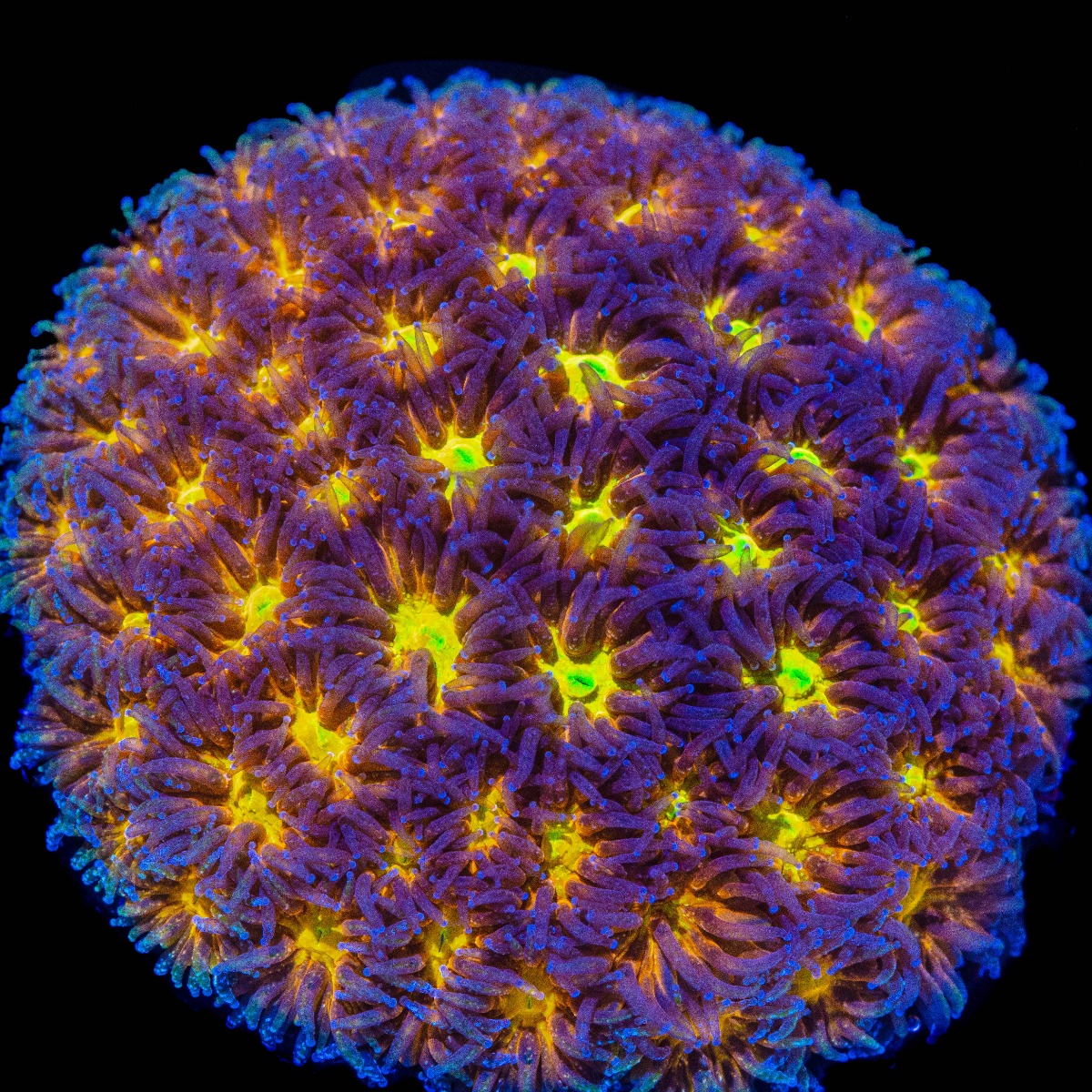
Spit Fire Leptastrea
Leptastrea are a relatively new species to the hobby and have never been a popular coral to the mainstream reef aquarist. They are a subtle short tentacled encrusting coral that appeal to veteran hobbyists that are looking for something different in their tanks. Novelty is a big thing when you have been in this hobby a long time and tanks start to suffer from sameness-syndrome. Sometimes a change of pace is necessary and uncommon corals like Leptastrea are just what the doctor ordered.
Here is some quick background on this coral. Prior to 2012 Leptastrea were assigned to the Family Faviidae but they have since been reclassified as Scleractinia incertae sedis which is Latin for ‘uncertain placement’. Everything sounds so much more official when spoken in a dead language. This classification change is due to the Faviidae group being reanalyzed and it showing that it was actually a large group of corals without a common ancestry that had been grouped together and is now being separated out. Such is the nature of coral classifications – they are ever changing.
Leptastrea are part of the LPS or large polyp stony corals which is a little non-intuitive given their small polyp size compared to other LPS such as single polyp monsters like Acanthophyllia or Scolymia. But in terms of care they fit right in with their LPS peers. As with all propagated corals there are many attractive named morphs available on the market right now. These morphs are given names to help identify different color varieties and the colors tend to have something to do with the name although that isn’t always strictly the case. One of the most popular has to be ‘John Deere’ with its Emerald Green rims and bright yellow/orange centers as per the John Deere logo. Others to keep an eye out for are our ‘Ice Blue’, ‘Purple and Green’ and ‘Burning Ember’. It is pretty much guaranteed that once you have one Leptastrea you will start hunting out another morph to add to your collection, they can be pretty addictive and look great kept together.

![]() Location
Location
Leptastrea are available as either wild colonies or aquacultured frags and there are benefits to both, which I will get to in a moment! They are currently imported from either Australia or from Indonesia although frequently smaller polyps show up on soft coral colonies occasionally as hitchhikers from areas such as Vietnam.
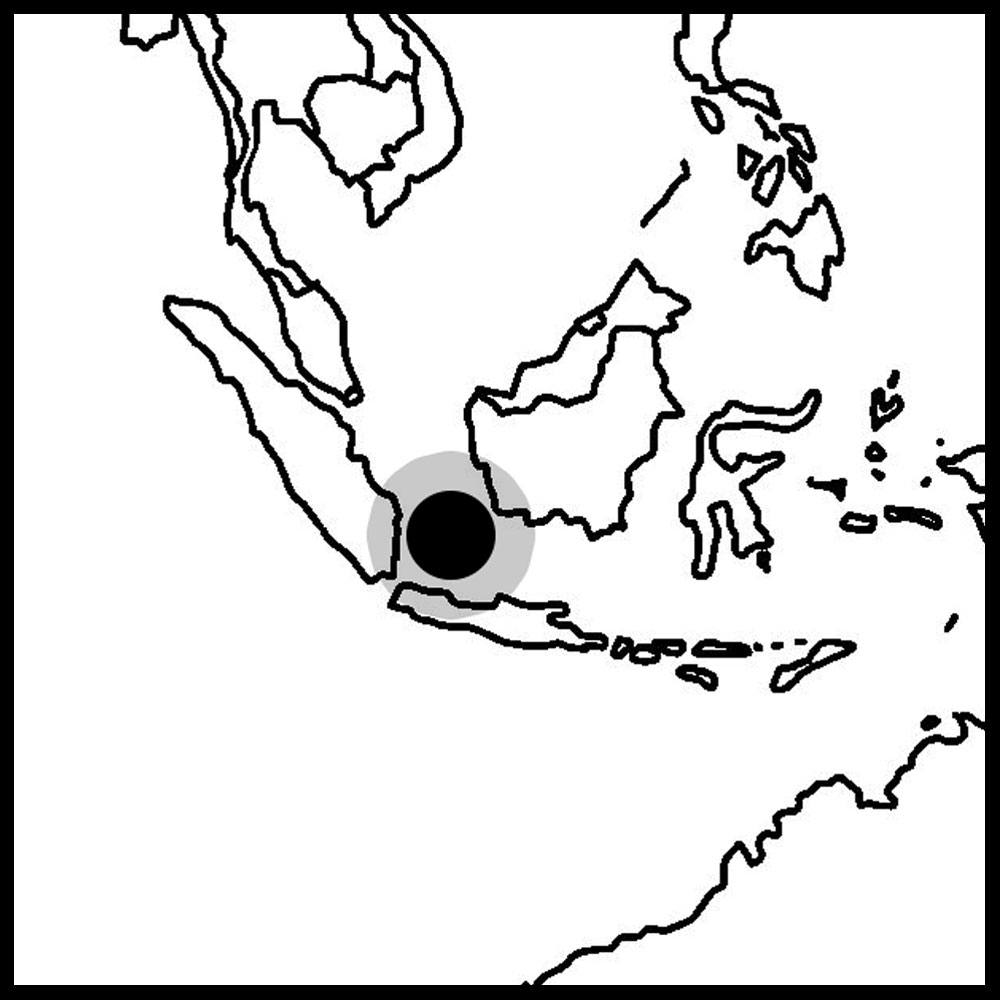
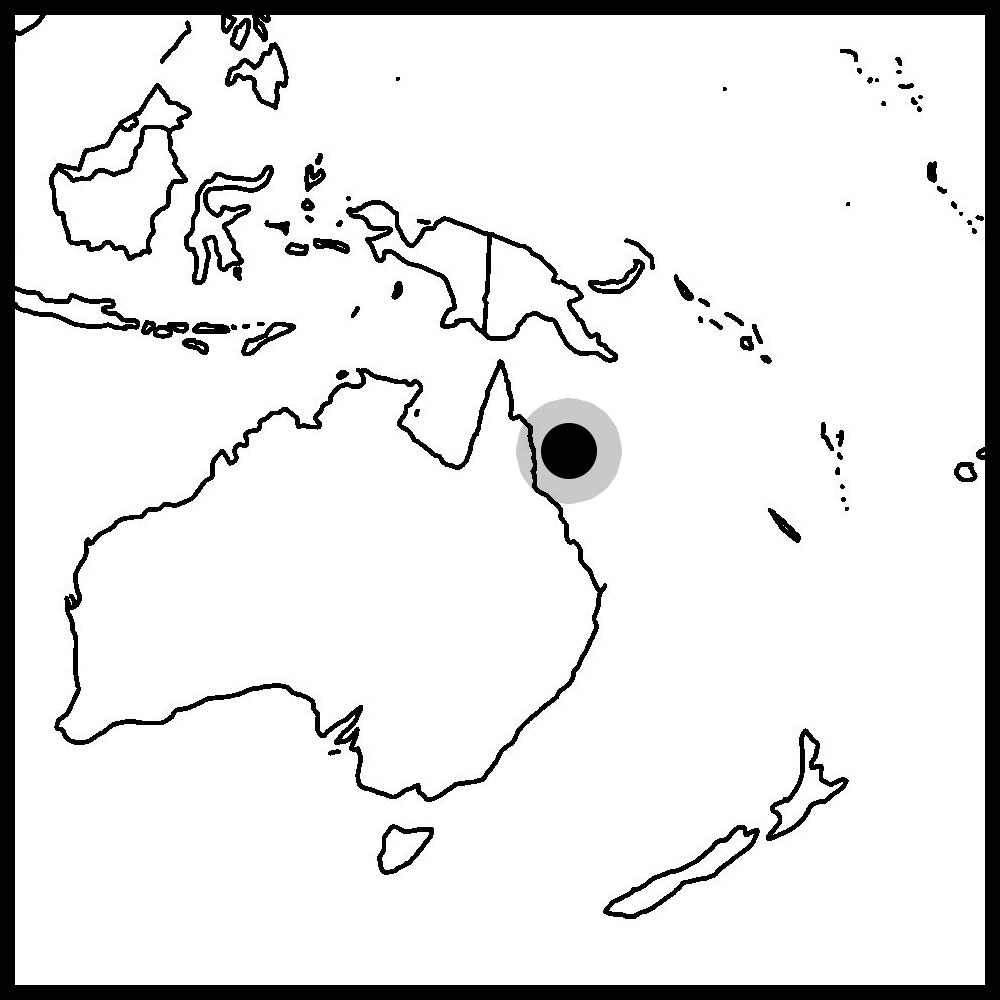
![]() Wild vs. Aquacultured
Wild vs. Aquacultured
The benefit of aquacultured sources is a much more robust animal. Corals grown in captivity have adapted to tank conditions and tend to survive and grow much better than recently imported corals. I personally love getting home grown corals whenever possible.
Having said that, there is an occasional perk with getting a wild colony of Leptastrea. They sometimes have interesting hitchhikers growing in the colony such as these blue paguritta hermit crabs. Normally I see these in Astreopora but occasionally I do see them in Leptastrea and Platygyra. They are a filter feeding hermit crab that makes its permanent home in this coral. I have also seen wild colonies come in with these tiny clams but unfortunately I don’t have any footage of those for you. I think they may be heavy filter feeders and do not survive well for us.
That’s a bit about their background so lets take a look at their growth and care requirements starting with feeding.
![]() Feeding
Feeding
If you are considering propagating these corals at home they make an excellent candidate for aquaculture. Initially they will encrust over new cuts and thinly spread out over their immediate surroundings but given time they will grow into larger boulder shapes. If you are trying to achieve a good growth rate then they will benefit from regular target feeding.
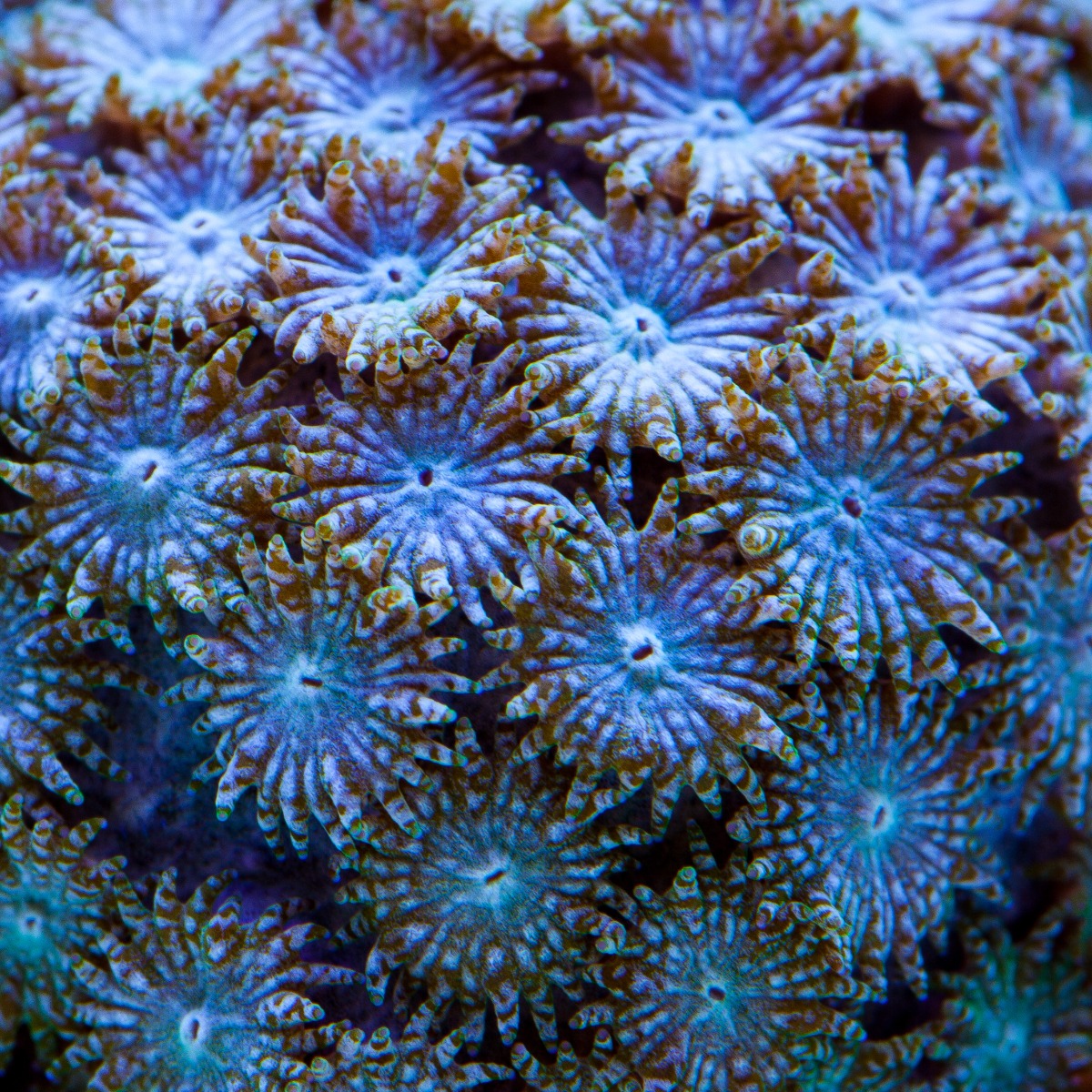
Ice Blue Leptastrea
I recommend feeding a mixture of smaller foods, both frozen and powdered a couple of times per week. They can more easily handle those smaller items although don’t be surprised to see one of those tiny polyps hanging onto a Mysis shrimp or a chunk of squid it has managed to snatch from the water column! There are plenty of foods that would be suitable on the market in either a dried or frozen form depending on your preference although in our experience a more concentrated dried formula initiates a better feeding response. You want something that is Zooplankton based and comprises of Rotifers, Cyclops or Copepods in either form. It is best to switch all pumps to feed mode or switch them off for roughly 30 minutes to allow you to target feed and for the coral to grab and ingest the food. Having said all that if you are not trying to intensively grow these corals then they are perfectly capable of grabbing smaller amounts of foods from the water column if you prefer to broadcast feed.

Now that we have covered feeding requirements, let's move on to lighting.
![]() Lighting
Lighting
The lighting requirements for Leptastrea depend in large part on the particular color morph. Generally speaking, Leptastrea do not like direct, intense light. Their color will be the best indicator of the position they prefer with green morphs tending to do better in a slightly higher PAR than orange morphs. Leptastrea are also pretty good at letting you know they are in too little light as their colors will fade or in the case of some green morphs they will brown out. 100 PAR would be a good final position for most aquacultured colonies which is a moderate light level. Light shock is very much a real thing and it is extremely important to slowly acclimate your coral to its final position to avoid stress and potential bleaching. It is far better for your coral to have too little light for a short period than too much light. On occasion hobbyists do keep Leptastrea in a more intensely lit position, it just takes a much longer period of acclimation in slowly raising the coral to an intense lighting location. In a higher PAR you will also lose one of their most appealing characteristics and that is their fluffy appearance. When the Leptastrea colony is overexposed to light, the polyps will appear much less extended and the flesh drawn tight to the base. A tip for acclimating coral is to take photos of new additions at weekly intervals so that it is easy to track their progress. This way you aren’t relying on your memory to see if the colors are getting better or if the coral is struggling and headed in the wrong direction.
Low Light


Lighting is a loaded topic, so for a more in-depth discussion of lighting, please see our Deep Dive article.
![]() Water Chemistry
Water Chemistry
As with all stony corals, water chemistry is an important requirement of their long term care. It is essential to be monitoring and maintaining your Calcium, Alkalinity and Magnesium levels. We like to target natural sea water levels for the three parameters but more important than specific numbers is stability. Large drops followed by quick increases are far more likely to negatively affect a coral than a low level that is slowly increased over a period of weeks or months.
Starting first with Calcium, it is one of the major ions in saltwater. In the ocean, its level hovers around 425 parts per million (ppm). As a coral grows calcium is absorbed from the water and used to forms its calcium carbonate skeleton.
![]() Alkalinity
Alkalinity
Alkalinity is probably the most important parameter to pay attention to. It is not a particular ion, but rather a general figure of carbonate availability in the water. Technically it is the amount of acid required to lower the pH of saltwater to the point bicarbonate turns into carbonic acid. If you have more alkalinity, it can soak up more acid. Less alkalinity and you have less buffering capacity making the tank more susceptible to chemical changes.
In practice alkalinity tends to be the parameter that fluctuates the most, so if you can only manage one test, test for alkalinity. In natural sea water, the alkalinity of the water measures around 7 or 8 dkh though most salt mixes these days mix up closer to 8 to 9 dkh. Some aquarists like to overload this parameter a little and keep their tanks around 10 or 11 dkh with the belief that having elevated calcium and alkalinity in the water contributes to faster stony coral growth.
Raising both calcium and alkalinity together can be tricky because of how they interact. Calcium ions and carbonate want to react with one another. Addition of a calcium supplements often comes with a corresponding fall in alkalinity levels and vice versa. If you are experiencing this in your systems, it is normal, but wild swings are not. If you are experiencing dramatic swings of calcium and alkalinity every time you use an additive, you may want to look at your Magnesium levels.
![]() Magnesium
Magnesium
So why Magnesium? Magnesium behaves chemically similar to calcium. It can bind up carbonate ions thus increasing the overall bioavailability of alkalinity compounds in the water. If you are tweaking calcium and alkalinity and getting strange results, you may want to make sure it is not your magnesium level that is low. In the ocean, Magnesium sits at about 1350 ppm.
Natural sea water levels for calcium are around 425ppm, alkalinity is around 6-ish dkh but we tend to shoot a little higher at around 8 dkh. Magnesium is around 1350ppm.
Another important aspect of your water chemistry to consider are your nutrient levels. In other words, Phosphates and Nitrates. Leptastrea do not like ultra low nutrient conditions, especially near-zero Nitrate. They like it a bit on the dirty side! So shoot for a Nitrate level above 5ppm but try to keep it below 30ppm to avoid some of the problems associated with high nitrate. If you happen to notice your Leptastrea suddenly start to recede check those nutrient levels. If you see your nutrient levels climbing then monitor your feeding. Ensure that what is being added to the tank is actually being eaten and not being sucked directly into a filter or behind a rock to break down. Feeding your tank is the most basic task but one that can go oh so wrong and cause plenty of problems so it is prudent to show special care rather than just throwing it in. I like to feed a lot but excessive feeding that goes unchecked can be the start of problematic algae issues so it is best to try to avoid it wherever possible.
![]() Water Flow
Water Flow
The final topic we will cover in terms of coral care is water flow. Leptastrea will benefit from enough flow to keep them clean and to ensure that detritus does not build up on top or around them. For this, a moderate, indirect flow pattern is best. There are many different ways to achieve this with many modern day pumps having random flow patters or wave patterns. You will know that the colony is getting enough flow if it is nicely puffed up and clean of detritus. You will know if you are overdoing it if the flow is slamming one side of the coral and it is drawn tight to the skeleton all the time.
![]() Summary
Summary
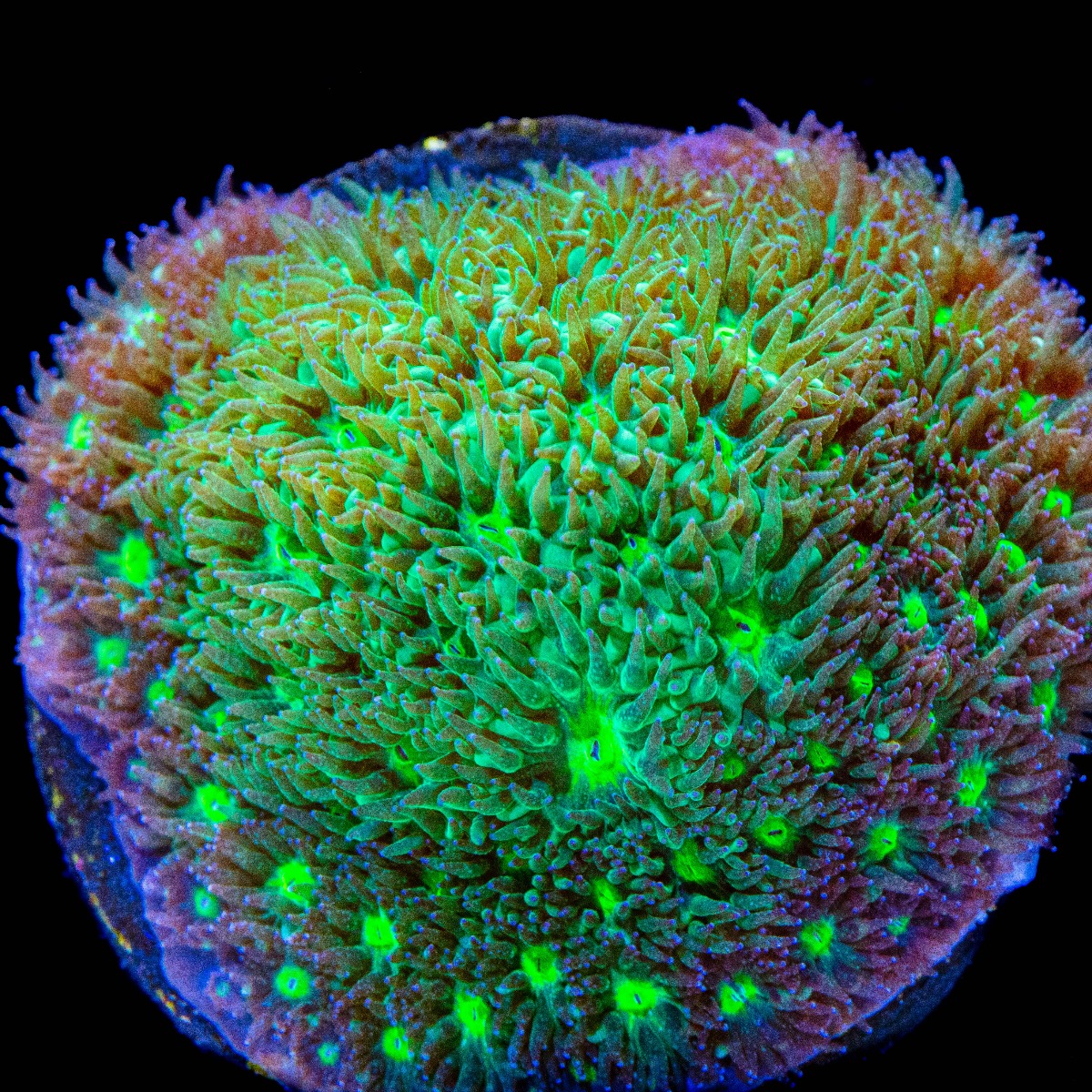
Goblin Leptastrea
Now that we know how to care for Leptastrea let’s look at how to propagate them. The simplest method is to take advantage of their encrusting nature and simply put a frag plug right next to the new growth of your current colony and allow it to slowly encrust onto it. Leptastrea are one of those corals that can cover your egg crate or frag rack if you leave them in the same spot too long so this can work in your favor. The other method is using a bandsaw to get a precise cut which can then be mounted using a coral glue onto a frag plug. There are a myriad of glues available but it is worth considering using a super glue activator to ensure a quick and secure bond to the plug. Often times these types of frags are not successful in aquaria because they are lost when they do not adhere to the plug correctly so take time in ensuring that it adheres successfully.
So before we finish this up it is worth finally mentioning placement and suitability. Leptastrea are a great choice for the lower areas in an aquarium which can often be a little tricky to populate. Their often vibrant colouration of either hot orange centers or vibrant green tentacles will really pop under blue LEDS so make sure that you dedicate a good amount of viewing time in those colors to really make the most of them. In terms of tank companions they are not hyper aggressive towards other corals unless they come in direct contact with them. It is worth considering the grow out space this coral will need as it encrusts onto surrounding rock work. It is also worth considering their neighbors and ensuring that nothing with large aggressive sweeper tentacles could attack the colony in the future. Species such as Euphyllia or Galaxea would not make a great neighbor for Leptastrea as the tentacles really can stretch a long way and it is easy to underestimate their reach as they grow.
Thanks for reading, and as always, happy reefing!
